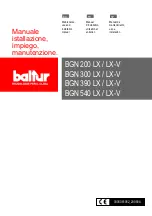
Page 6
Confined Space
A confined space is an area with a volume less than 50 cubic
feet (1.42 m
3
) per 1,000 Btu (.29 kW) per hour of the com
bined input rating of all appliances installed in that space. This
definition includes furnace closets or small equipment rooms.
When the furnace is installed so that supply ducts carry air cir
culated by the furnace to areas outside the space containing
the furnace, the return air must be handled by ducts which are
sealed to the furnace casing and which terminate outside the
space containing the furnace. This is especially important
when the furnace is mounted on a platform in a confined space
such as a closet or small equipment room. Even a small leak
around the base of the unit at the platform or at the return air
duct connection can cause a potentially dangerous negative
pressure condition. Air for combustion and ventilation can be
brought into the confined space either from inside the building
or from outside.
EQUIPMENT IN CONFINED SPACE
ALL AIR FROM INSIDE
WATER
HEATER
OPENINGS
(To Adjacent
Room)
NOTE-Each opening shall have a free area of at least one square
inch (645 mm
2
) per 1,000 Btu (.29 kW) per hour of the total input rat
ing of all equipment in the enclosure, but not less than 100 square
inches (64516 mm
2
).
G24M
FURNACE
CHIMNEY
OR GAS
VENT
FIGURE 1
Air from Inside
If the confined space that houses the furnace adjoins a space
categorized as unconfined, air can be brought in by providing
two permanent openings between the two spaces. Each
opening must have a minimum free area of 1 square inch
(645 mm
2
) per 1,000 Btu (.29 kW) per hour of total input rat
ing of all gas-fired equipment in the confined space. Each
opening must be at least 100 square inches (64516 mm
2
).
One opening shall be within 12 inches (305 mm) of the top of
the enclosure and one opening within 12 inches (305 mm) of
the bottom. See figure 1.
Air from Outside
If air from outside is brought in for combustion and ventilation,
the confined space must have two permanent openings. One
opening shall be within 12 inches (305 mm) of the top of the
enclosure and one opening within 12 inches (305 mm) of the
bottom. These openings must communicate directly or by
ducts with the outdoors or spaces (crawl or attic) that freely
communicate with the outdoors or indirectly through vertical
ducts. Each opening shall have a minimum free area of 1
square inch (645 mm
2
) per 4,000 Btu (1.17 kW) per hour of
total input rating of all equipment in the enclosure. See
figures
2 and 3. When communicating with the outdoors through hori
zontal ducts, each opening shall have a minimum free area
of 1 square inch (645 mm
2
) per 2,000 Btu (.56 kW) per total
input rating of all equipment in the enclosure. See
figure 4.
When ducts are used, they shall be of the same cross-sec
tional area as the free area of the openings to which they con
nect. The minimum dimension of rectangular air ducts shall
be no less than 3 inches (75 mm). In calculating free area,
the blocking effect of louvers, grilles, or screens must be
considered. If the design and free area of protective covering
is not known for calculating the size opening required, it may
be assumed that wood louvers will have 20 to 25 percent free
area and metal louvers and grilles will have 60 to 75 percent
free area. Louvers and grilles must be fixed in the open posi
tion or interlocked with the equipment so that they are opened
automatically during equipment operation.







































